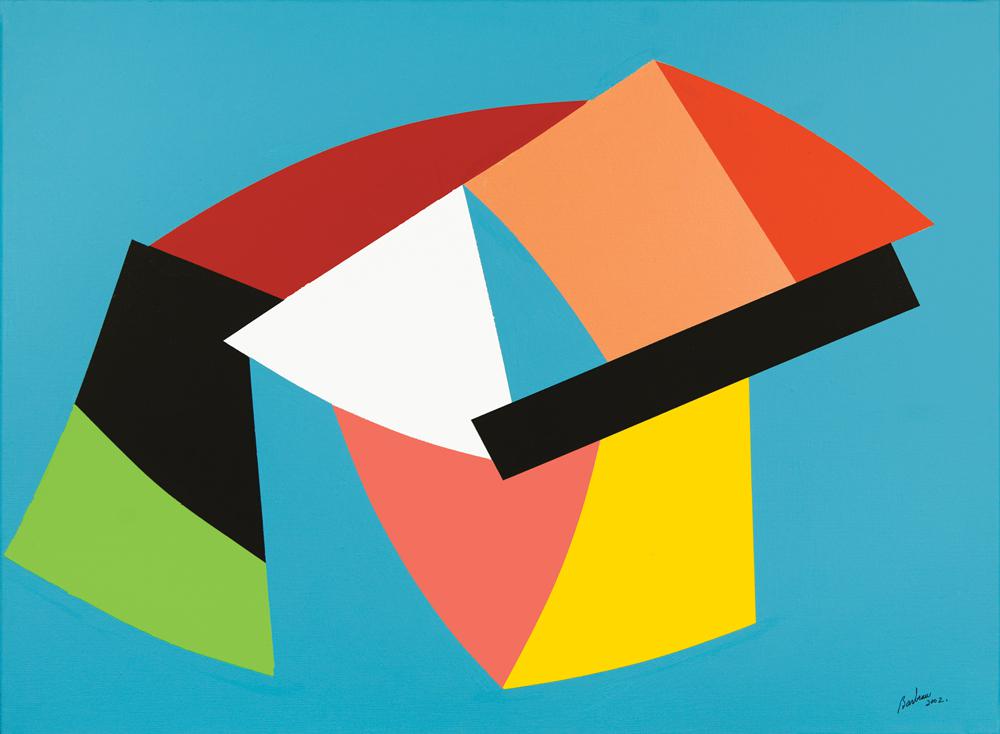Marcel Barbeau is the grand old man of Quebec art and in top creative form at 88. The multiplicity of his work is astounding as he engages painting, sculpture, printmaking and collage.
Earlier this year, his Canada-wide reputation was reaffirmed when Barbeau was named a recipient of a Governor General’s Award in Visual and Media Arts. In parallel timing, Montreal’s Galerie d’art Michel-Ange presented a retrospective of Barbeau’s work that emphasized his recent production.
Barbeau moves back and forth between gestural exploration and his own version of geometric abstraction. He presents an eloquent vocabulary of angular shapes that succeed in “floating” in a peculiar way in pictorial space, conjuring a subtle atmosphere of psychological elation. In Saisons (2004) and Souvrire étoilé (2002), for example, forms that suggest plane geometry, yet are characteristically curved, seem to poetically take off into space. The artist speaks of his recurrent “cosmic vision.” His expression spans from geometric paintings to Tachiste works. Barbeau’s work in metal sculpture, exemplified in this show by the aluminum pieces Portique 2 (2010) and L’Échelle des ombres fugitives (2010), demonstrates both a playfulness in space and an authoratative offhand ease in dominating it.
In a series of acrylic paintings titled Impressions des cantons de l’est from the early 2000s, Barbeau invests space with a subtle calligraphy of mostly primary colours, replete with transparencies and interspersed with a shower of blots, dots and drippings. His expression may range from whimsical chromatic gestures to maplike, interlocking, space-defining shapes. Barbeau’s tones are generally thinly applied as colour fields, lacking relief or projections.
In the recent Mangrove series (2012–13), painted during a Christmas stay in Florida’s Sanibel Island, figurative references are subtly introduced. Oscillating between geometry and gesture, with an abundance of blues, yellows and oranges, Barbeau creates a vocabulary of bright colours that suggest tropical rhythms.
His latest work constitutes a discreet, allusive exploration of nature, ever so subtly implied. The art stays thoroughly abstract, yet the artist admits to “possible inspiration” from nature, in an indirectly expressed postmodern hybridity. As Barbeau chooses from a repertory of styles practiced throughout his career, he evokes biological shapes in the recent work. He calls his latest approach to composition “anaconstruction,” a form of deconstruction that may be described as an abolition of pictorial objects originally suggesting three dimensions.
In 2012, Barbeau was commissioned to produce a large, four-panel mural titled Les angles du regard for the Montreal Construction Trades School as part of a government initiative to integrate visual art and architecture. In a remote and roundabout way, the major work evoked the formation and destruction of a city landscape—something that Barbeau has seen and seen again over the years in Montreal, his native city.
This is an article from the Winter 2014 issue of Canadian Art. To read more from this issue, check out its table of contents. And to read the entire issue, pick up an issue on newsstands, the App Store or Zinio till March 14.

 Marcel Barbeau, Les angles du regard (detail), 2012. Four acrylic paintings on aluminum panels, 1.82 x 1.82 m each. Photo: Robert Etcheverry.
Marcel Barbeau, Les angles du regard (detail), 2012. Four acrylic paintings on aluminum panels, 1.82 x 1.82 m each. Photo: Robert Etcheverry.







